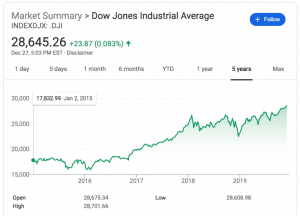
Year-End Fundraising 2019 Wrap Up
Happy New Year!
Overall, it was a good year. Let’s take a look back at economic trends, how that impacted 2019 year end giving, and then on to the fun stuff — it’s time to start laying the groundwork for next December, especially with this being an election year.
2018 vs. 2019 Economic Overview
December 2018 was the worst December for stocks since the Great Depression. There was almost a government shutdown. The Dow Jones Industrial Average was 5,000 points lower on December 31, 2018, than it was on December 31, 2019.

By comparison, people spent money with confidence in December 2019, and the lack of volatility boded well for nonprofits’ year-end pushes.
With this top-level view to ground us, let’s jump into campaign-specific observations.
Year-End Highlights
Cultivation emails: Across the board, we’re seeing a similar campaign message cadence of early November cultivation warm fuzzies, a note to say Happy Thanksgiving, an ask around Giving Tuesday, more December touchpoints, a “Happy Holidays” send, and a year-end ask.
Does it work? Last year, we tested adding more “non-ask” emails to Stand Up To Cancer’s schedule to see if it would lift overall response rate. The test group received three additional cultivations and that group drove 3% more gifts, 16.1% more revenue and had a higher average gift. Storytelling is important, and one tactic you should employ year-round. Keep in mind that stewardship and cultivation are ‘always-on’ activities that require constant attention and monitoring.
Facebook Fundraisers: Many orgs posted Facebook Fundraisers on Giving Tuesday hoping to take advantage of the Facebook $7 million match. In 2018, the match was gone within the hour so Facebook lowered the cap to $100,000 in 2019 so that more organizations could benefit.
Orgs raised $120 million on Facebook on Giving Tuesday 2019. Over 1.1 million people created fundraisers or donated, and over 97,000 charitable organizations benefited from Facebook fundraisers.
Whether you get the match money from Facebook or not, we recommend setting up Facebook fundraisers on key giving days. And most importantly, have a plan to cultivate those donors after the fundraiser. You may be asking, “How do I cultivate these donors when I don’t have the data?” There is a way! Stay tuned for a blog next month with details. Or, contact us so we can loop you in early.
(Side note: We aren’t seeing donation behavior pick up through Instagram yet, but the storytelling is impressive.)
Matches: While we’re talking matches, at least one org was promoting a 10x match. Most were 2x and 3x. Do donors really believe their gift is being matched 10 times?
Most organizations have to be thoughtful around leveraging a limited match pool budget. If this is the case for you, consider prioritizing who receives a match offer as opposed to how much the match offer is. For example, perhaps serve up a match offer to only your non-donors based on what your data tells you about which audiences are more responsive to that messaging historically. What offer and what channel propelled conversion most last year? Use that data to guide you — and be sure your tracking is set up to tell you what performs best this year if you’re noticing holes.
If you are an organization with plenty of matching funds, consider the perceived value increase in the match offer. Increase the offer as you approach your end of year deadline. Don’t start at 10x, because, well, where do you go from there?
Our most nontraditional campaign: Our client, Herbalife Nutrition Foundation, wanted to try something new this year.
Instead of asking for unrestricted donations and using the available match money to incentivize donors, they asked their casa partners around the world to apply to compete in a peer-to-peer challenge where 25 casas were racing to reach $25,000 and a chance to receive a $25,000 match. The number of overall donors increased 65% and dollars raised more than doubled. Don’t be afraid to break the mold to find an offer that may resonate more with your audience.
Monthly Giving? In December? Yes. And double yes. Augmenting your end-of-year campaign with a monthly giving component can be quite beneficial. We had one client garner over $80k in annualized new monthly revenue during December in addition to nearly $1M in one-time revenue.
Next year, consider running your paid ads as monthly-donor-first or consider deploying an upsell lightbox at the moment of a one-time gift. Or, you could add an automated and targeted thank you series to your end of year donors to consider becoming a monthly donor.
2020 Year-End Prep Starts Now
What should you be doing now to prepare for #GivingTuesday 2020?
- Wrap Up 2019 – Debrief as early as possible and set a timeline (with meeting invites and agendas) for upcoming 2020 EOY planning — start early enough in summer 2020 to get the gears rolling. And capture things that worked or needed improvement while they’re still fresh.
- Lead generation – you have all year to start capturing and cultivating new leads. Start building those relationships as early as possible through new lead gen strategies, welcome series, reactivation campaigns, etc.
- Evaluate your Paid Advertising Strategy – We recommend a year-long paid strategy, check out 4 Reasons to Start Thinking About Your Ads Program as Year-Round.
As always, we’d love to help with your full-year strategy. We hope to hear from you soon!